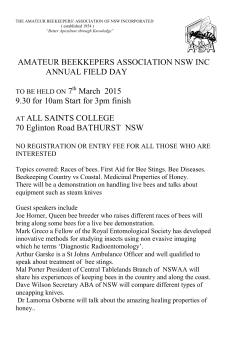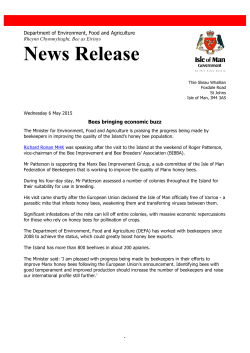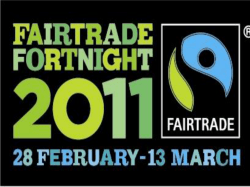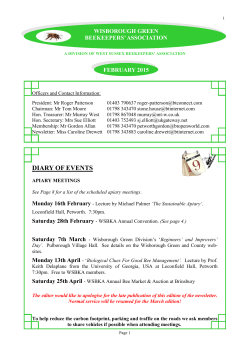
BEE GARDENS - UMass Extension
Sweat bee on Clethra Why Develop a bee garden? Your business can lead the way! Your customers are always looking for new things! Your bee garden will inspire them. More information How to build bee blocks: www.umaine.edu/blueberries/factsheets/bees Factsheet #301 You and your garden center customers can help protect the bees! Wild bee conservation: www.umaine.edu/blueberries/factsheets/bees Factsheet #630 Bee forage plants for North America: www.xerces.org/pollinator-‐conservation-‐ publications BEE GARDENS Why not plant one at your garden center? Many gardeners are eager to encourage beneficial insects on their land, and are curious about honey bees and New England’s 400 species of wild native bees. New information, including findings from our research, can help you sell plants that reliably attract bees. Many bee-‐friendly plants are easy to grow and in demand. If the bees are happy, butterflies, flies, beetles and other pollinators will come to the garden as well. Why is this important? News of Colony Collapse Disorder has created widespread concern and awareness of the importance of bees and biodiversity. Without bees in the Northeast, our food supply is in jeopardy. Our apples, blueberries, cucumbers, cranberries, pumpkins, squashes and many other crops depend on bees for adequate pollination. Sweat bee on Cosmos ‘Sea Shells’ This brochure was prepared by botanist Dr. Alison C. Dibble, Research Entomologist Dr. Frank Drummond, and horticulturist Dr. Lois Berg Stack. Support by the USDA, New England Floriculture Inc and New England Grows is gratefully acknowledged. All photos by Alison C. Dibble. Published and distributed in furtherance of Cooperative Extension work, Acts of Congress of May 8 and June 30, 1914, by the University of Maine and the U.S. Department of Agriculture cooperating. Cooperative Extension and other agencies of the USDA provide equal opportunities in programs and employment. 11/12. Any material that advertises or invites people to participate in our programs also needs UMaine Extension’s TDD number, 1-800-287-8957, along with the Americans with Disabilities Act (ADA) Notice. A bee garden in your garden center o supports local bees o provides information to your customers o allows you to display and sell the plants that do support native bees and honey bees It’s All About Habitat Bees need food: Plant a variety of flowers that provide the pollen and nectar all season. Early-‐season: Acer (maple) Amelanchier (shadbush) Anchusa (bugloss) Bergenia (pigsqueak) Crocus (crocus) Malus (apple) Prunus (cherries and plums) Pulmonaria (lungwort) Salix (willow) Viola (violet; perhaps not pansies, though) Midseason: Agastache (anise hyssop) Asclepias (milkweed) Borago (borage) Echinacea (coneflower) Liatris (blazing star) Mentha (mint) Oreganum (oregano) Rosa (roses) Spiraea (spirea) Tagetes (marigold, especially single French types) Late season: Aster (many wild asters) Clethra (summersweet) Cosmos (pink cosmos) Echinacea (purple coneflower) Gentiana clausa (bottle gentian) Phlox (summer phlox) Rudbeckia (yellow coneflower) Solidago (many wild goldenrods) Orange-‐banded bumble bee on Bergenia A word of caution Bees are weakened or killed by pesticides, especially insecticides. Avoid pesticides … and educate your customers to do the same. Identify problems and treat them in ways that reduce or eliminate pesticide use. Bees Need Water: Float a piece of wood in a birdbath to provide a landing platform. Our Project Bees Need Nest Habitat: Provide a variety of sites to accommodate a variety of bees. Ground-‐nesting bees often nest in patches Leafcutter bees lay eggs in south-‐facing of bare compacted soil, often at garden bee boxes. A local carpenter might help edges and along garden paths. you develop a clever and unique design. Some bees nest in hollow stems; decorative bundles of stems might sell well. Our 5-‐year project began in spring 2012. At four Maine sites, we are collecting data about which plants can best provide honey bee and native bee resources. Our thirty plant types include annual flowers and herbs, shrubs, and herbaceous perennials – in other words, plants that represent many of the types of plants your customers might buy for their own bee gardens. Stay tuned! For more information, email Lois.Stack@maine.edu
© Copyright 2025













